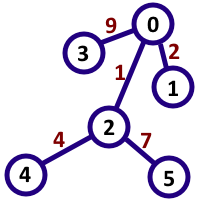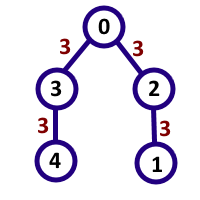CF715C.Digit Tree
普及/提高-
通过率:0%
AC君温馨提醒
该题目为【codeforces】题库的题目,您提交的代码将被提交至codeforces进行远程评测,并由ACGO抓取测评结果后进行展示。由于远程测评的测评机由其他平台提供,我们无法保证该服务的稳定性,若提交后无反应,请等待一段时间后再进行重试。
题目描述
ZS the Coder has a large tree. It can be represented as an undirected connected graph of n vertices numbered from 0 to n−1 and n−1 edges between them. There is a single nonzero digit written on each edge.
One day, ZS the Coder was bored and decided to investigate some properties of the tree. He chose a positive integer M , which is coprime to 10 , i.e.  .
.
ZS consider an ordered pair of distinct vertices (u,v) interesting when if he would follow the shortest path from vertex u to vertex v and write down all the digits he encounters on his path in the same order, he will get a decimal representaion of an integer divisible by M .
Formally, ZS consider an ordered pair of distinct vertices (u,v) interesting if the following states true:
- Let a1=u,a2,...,ak=v be the sequence of vertices on the shortest path from u to v in the order of encountering them;
- Let di ( 1<=i<k ) be the digit written on the edge between vertices ai and ai+1 ;
- The integer
 is divisible by M .
is divisible by M .
Help ZS the Coder find the number of interesting pairs!
输入格式
The first line of the input contains two integers, n and M ( 2<=n<=100000 , 1<=M<=109 ,  ) — the number of vertices and the number ZS has chosen respectively.
) — the number of vertices and the number ZS has chosen respectively.
The next n−1 lines contain three integers each. i -th of them contains ui,vi and wi , denoting an edge between vertices ui and vi with digit wi written on it ( 0<=u_{i},v_{i}<n,1<=w_{i}<=9 ).
输出格式
Print a single integer — the number of interesting (by ZS the Coder's consideration) pairs.
输入输出样例
输入#1
6 7 0 1 2 4 2 4 2 0 1 3 0 9 2 5 7
输出#1
7
输入#2
5 11 1 2 3 2 0 3 3 0 3 4 3 3
输出#2
8
说明/提示
In the first sample case, the interesting pairs are (0,4),(1,2),(1,5),(3,2),(2,5),(5,2),(3,5) . The numbers that are formed by these pairs are 14,21,217,91,7,7,917 respectively, which are all multiples of 7 . Note that (2,5) and (5,2) are considered different.
 In the second sample case, the interesting pairs are (4,0),(0,4),(3,2),(2,3),(0,1),(1,0),(4,1),(1,4) , and 6 of these pairs give the number 33 while 2 of them give the number 3333 , which are all multiples of 11 .
In the second sample case, the interesting pairs are (4,0),(0,4),(3,2),(2,3),(0,1),(1,0),(4,1),(1,4) , and 6 of these pairs give the number 33 while 2 of them give the number 3333 , which are all multiples of 11 .
